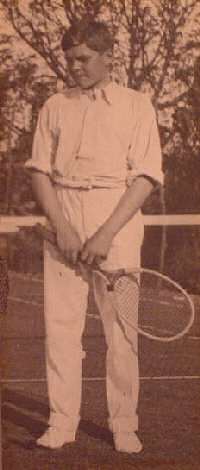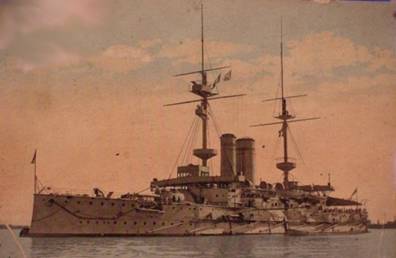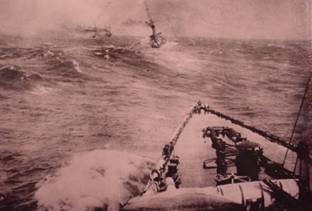|

The
Young Philip Malet de Carteret
|
At 4.26pm on 31st May, 1916, a terrific explosion
occurred on the British battle-cruiser, HMS Queen
Mary, at the beginning of the greatest of modern
sea battles of the 20th century - Jutland. One
and a half minutes later, the ship sank with a
complement of 1,266 officers and crew, of which
there were 20 survivors. Philip Malet de Carteret
was not one of them.
Born in Sydney, Australia on 23rd January, 1898,
Philip was the eldest son of Jurat Reginald Malet
de Carteret (1865-1935), Seigneur of St. Ouen's
Manor in Jersey. He was educated at Ebor Preparatory
School in Lausanne (1907) and Mr Rhodes' Mottingham
and Eltham College, before entering RNC Osborne
in 1911. He took first prize in French on leaving
for RNC Dartmouth in 1913 to take his Midshipman's
course.
His father, Reginald had left Jersey for Australia
and en-route met and married there in 1895, Amy
Anne Armstrong (1865-1950). Philip's younger brother,
Guy was born in 1901 and an elder sister, Ella
Marie (Ellie) had been born in 1896.
Philip was a keen sportsman. His 54 surviving
letters written during the Great War constantly
narrate sporting events - swimming, hockey matches
and tennis. He wrote 37 letters to his father,
15 to Guy and 2 to Elizabeth (Grandma). 7 were
written prior to 1914.
|

HMS Canopus
|
Canopus was at first patrolling in the North
Atlantic, when she was ordered to assist the South
Atlantic Battle Squadron of Admiral Sir Christopher
GFM Cradock.
The ship arrived in Port Stanley on the 20th
October. Cradock's squadron had already left in
pursuit of the German squadron under the command
of Vice-Admiral Count von Spee.
HMS Canopus
Canopus left for the Magellan straits on 23rd
October to join the rest of the British squadron,
which consisted of three old armoured cruisers,
Good Hope (the flagship two 9.2 inch modern guns
with a range of 13,500 yards and sixteen 6 inch
guns), Monmouth (fourteen 6 inch guns) and Cornwall,
two light cruisers, Glasgow (2 modern 6 inch and
ten 4 inch guns) and Bristol, and the armed merchant
cruisers Otranto, Macedonia and Orama.
|
Cradock's ships were far inferior in both
firepower and age to von Spee's squadron which consisted
of the two modern cruisers the Scharnhorst (twelve 8.2
inch guns with a range of 13,500 yards and also 5.9
inch guns with a range of 11,000 yards) and Gneisenau
(twelve 8.2 inch guns) both of which had sailed from
the China Sea to the South Pacific together with three
light cruisers, the Leipzig (ten 4.1 inch guns with
a range of 11,500 yards), Dresden and Nurnberg.
The German officers and crew numbered
some 2,200. They were seasoned professionals in the
main and had served together for over a year. The vast
majority of the British crews on the other hand had
been civilians less than six months previously.
The Battle Of Coronel
The Battle of Coronel, off the coast of
Chile, took place on 1st November. Winston Churchill,
the First Lord of the Admiralty was convinced that Cradock
had orders not to engage the Germans without the protection
of Canopus. However Canopus was slow and although she
was steaming towards the British fleet at 15 knots,
Cradock thought she was travelling at 12.5 knots. She
had two colliers with her and at 6.18 pm Cradock increased
his speed to 17 knots and radioed Canopus with a message
"I am about to attack the enemy now"
At 7.04 pm the Germans opened fire at
a range of 12,000 yards. The Scharnhorst hit the Good
Hope with its third salvo and rendered the fore 9.2
inch gun useless. It continued to fire four salvoes
a minute. By 7.23 pm the range was 6,600 yards. At 7.53
pm, the Good Hope was shattered by an explosion which
produced a column of flame that rose over 200 feet above
her decks.
Canopus had intercepted a message from
Glasgow to the Good Hope reporting the enemy in sight.
She increased to full speed and dispatched her colliers
to Juan Fernandez and headed northwards in the hope
that she would arrive in time to engage the enemy. At
about 9.00 pm she received a signal from Glasgow that
it was feared that the Good Hope and Monmouth were lost
and the fleet scattered. Canopus turned around, picked
up her colliers and made back for the Magellan Straits
via Smyth's Channel, probably the first battleship to
make use of them, a great navigational credit to her.
Cradock perished along with 1,600 men.
Rear-Admiral Stoddart was now in command
in the South Atlantic, on the Carnarvon and he decided
to go south to Montevideo to meet the remainder of the
scattered fleet.
It was just before Coronel, that a great
management change was taking place in the Navy. Prince
Louis of Battenberg was being hounded out of office
as First Sea Lord because he was German born. He had
resigned on 29th October and was replaced by Lord Jackie
Fisher, a formidable old gentleman who had been in the
post from 1904-1910 and who had been in charge of the
Navy overseeing its complete transformation into the
greatest fleet in the world.
On the 6th November, Canopus was back
in the Falklands but was ordered go to Montevideo but
was called back and arrived in Port Stanley on 13th
November. Canopus could not get a reply from the Wireless
Station in Port Stanley and thought that the harbour
had been captured by the Germans. The islanders thought
that they were the enemy. The island had at that time
a population of about 1,000, mainly Scottish crofters.
|

Admiral von Spee's Battle Squadron
26th November 1914
Finally, Canopus was ordered back to Port Stanley
to act as guardship. Captain Grant took the ship
through the outer bay and into the land locked
harbour itself and finding that anchors and warps
could not hold the ship, he grounded the ship
so that her broadside could fire over a low neck
of land and into the required beaten zone.
The upper decks of the ship were daubed with
all colours of the rainbow, an observation and
gunnery control post were set up, twelve-pounder
guns were sent ashore and mounted in three batteries.
|
Letter to Reginald dated
4th December 1914 and published in "The Morning
Post" of 21st January 1915
My Dear Dad,
I wish you a very happy Christmas!
We are still in the Falkland Islands and are organising
a proper defence in case the enemy meditate an attack.
The only thing worth having is the Wireless Station,
which is valuable to us as it is the only British Wireless
Station in these parts.
You have doubtless seen in the papers
all about the German armed merchantman Kaiser Wilhelm
der Grosse being sunk by our cruiser Highflyer. Well
we had been specially sent out to the North Sea to sink
her, but before we got there, we found our work had
been done for us by the Highflyer. We were frightfully
sick.
Do you remember seeing about a midshipman
on the Cressy who saved 87 lives (or thereabouts) including
that of his commander, when the Cressy, Houge and Aboukir
went down. His name was Cazalet. Well he was a chap
in our term who had mobilised with us at Dartmouth.
Of course we were very glad to see it although we were
sorry to see the list of the drowned midshipmen whom
were in our term also. Talking of drowned people, eight
people were drowned here while crossing a creek in a
punt three days ago. The punt capsized, and none of
them could swim so they were all drowned. They were
not men from the ship, but from the shore. They grappled,
dredged and dived for their dead bodies and succeeded
in recovering seven. I had to convey them to the Town
in my boat. It was pretty ghastly work!
Although the Canopus seems to have
taken but a small part in the war yet she has really
done more than any other ship hereabouts, and a good
deal more than most ships in the Navy, for although
we have not fought an action, yet we have kept all the
trade routes clear and unmolested and frightened away
any marauding German armed merchantmen or cruisers,
that might have been skulking around.
We have run the ship hard and fast
on to the mud (on purpose) so it looks as if we were
going to stay here till the end of the war - whenever
that will be.
Our poor dilapidated engines have at
least got a rest after tramping up and down the Atlantic
and Pacific Oceans for weeks on end with scarcely an
interval.
I hope everyone at home is quite fit
and well
With love to all from your affectionate son
Philip
Lord Fisher acted swiftly. He ordered
the immediate release of three battle-cruisers to serve
in the Atlantic, two to go to the Falklands, Invincible
and Inflexible, and one, the Princess Royal to the West
Indies to guard the Panama Canal.
On 7th December the battle-cruisers arrived
in Port Stanley with Vice-Admiral Sir Frederick Doveton
Sturdee flying his flag in Invincible as Admiral of
the Squadron. His mission was the annihilation of Von
Spee's squadron.